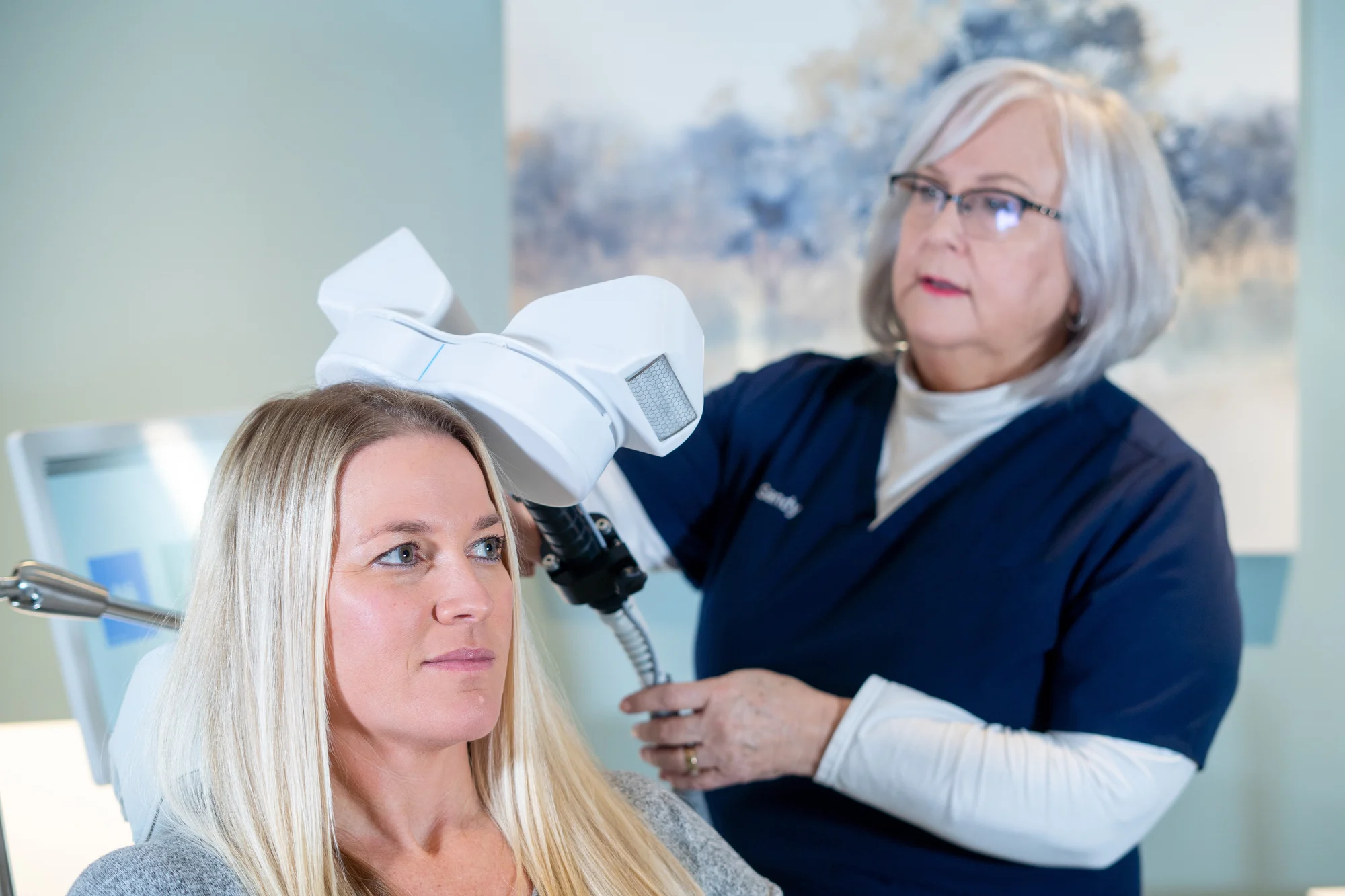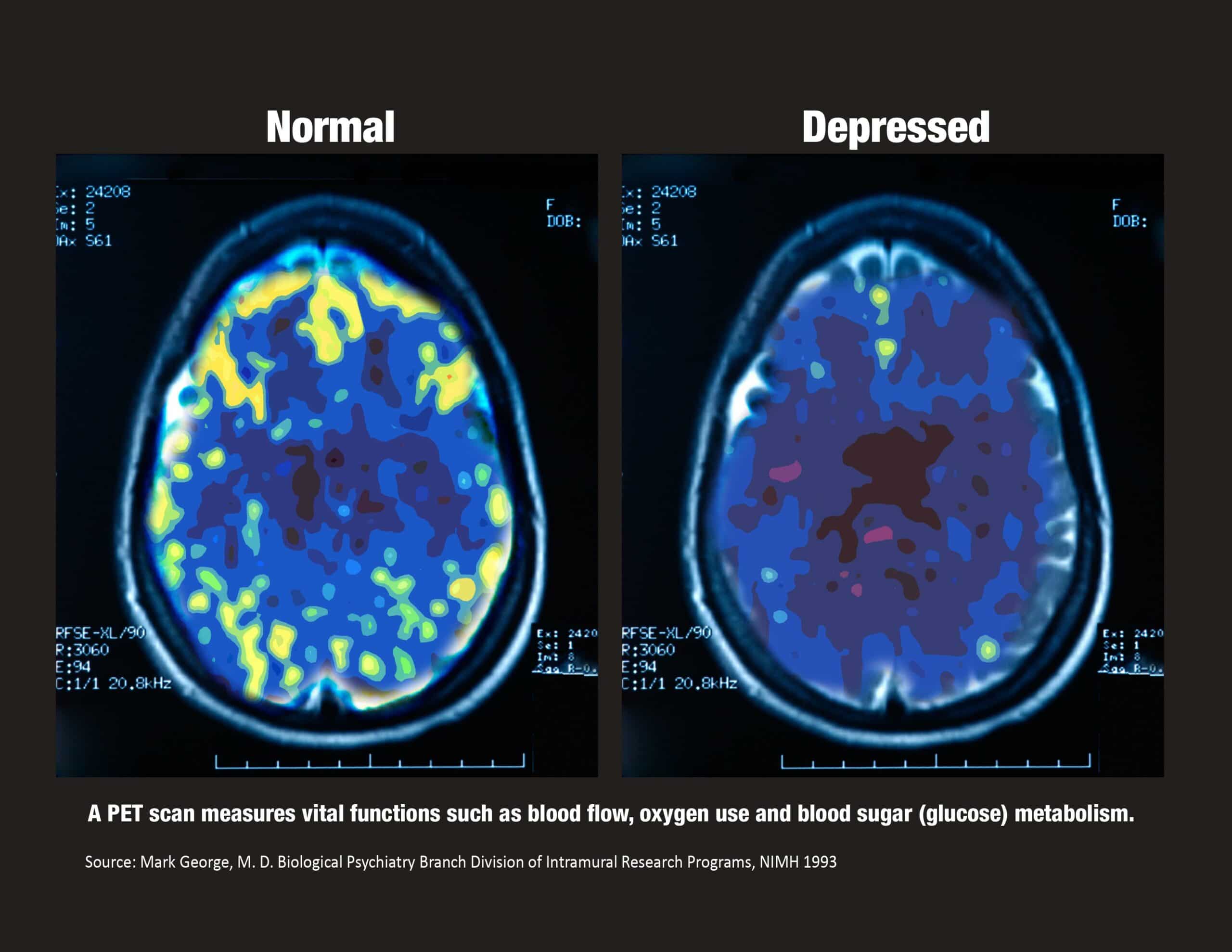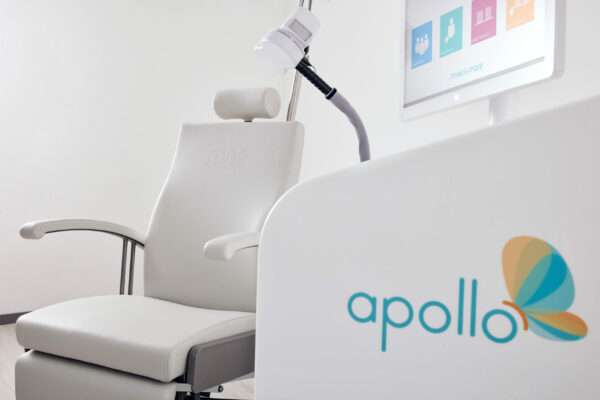Transcranial Magnetic Stimulation (TMS)
Hope Beyond Prescriptions

What is TMS Therapy?
FDA-Approved Depression Treatment
TMS is a breakthrough depression treatment. It uses MRI strength magnetic pulses to stimulate areas of the brain that are under active in patients with depression.
Covered by Insurance
TMS therapy is covered under most health insurance plans
Non-Invasive
TMS is non-systemic (not through the whole body like medication) and non-invasive (not entering the body).
No Changes in Daily Activities
TMS does not require anesthesia or sedation, so patients can resume normal daily activities following each treatment. Treatment typically lasts for about 20 minutes.
Is TMS Therapy Right For Me?
If medications for depression haven’t provided sufficient relief or have caused disruptive side effects, consider TMS Therapy as an alternative solution. It offers hope for more effective treatment.
- Have you taken more than 1 antidepressant medication?
- Have medications failed to provide adequate relief from your depression symptoms?
- Have you experienced side effects from medication that outweigh the benefits?
If you answered yes to any of the above, it may be time to speak with a provider about TMS therapy.


Achieve Lasting Relief in 3 Simple Steps
Step 1: Recline
Treatment will take place at a BestMind location in one of our comfortable reclining TMS chairs.
Step 2: Relax
Treatment lasts for about 20 minutes. You will be fully awake, able to drive home and return to your daily activities.
Step 3: Repeat
Treatment is prescribed for a total of 36 sessions for long-term relief from MDD and TRD.
Have more questions about TMS Therapy?
How is TMS therapy different from depression medication?
TMS differs from traditional drug therapy because it uses MRI-strength magnetic pulses targeted only to specific regions of the brain that are known to be under-active in those diagnosed with major-depressive disorder or treatment-resistant depression. TMS activates and raises the levels of neurotransmitters in the brain – and can be used in conjunction with medication or as a stand-alone treatment.
Does TMS therapy hurt?
No, TMS therapy is typically regarded as painless, although few patients have reported mild discomfort during treatment. Described as a tapping feeling.
Is there a recovery period after receiving TMS therapy?
Is TMS the same as shock therapy?
TMS Therapy FAQ
Who is TMS therapy for?
TMS is recommended for people who haven’t found relief from standard depression treatments, also known as treatment-resistant depression.
eyond its primary use, TMS has shown value for off-label applications such as anxiety, PTSD, and OCD. Currently, these uses have limited insurance coverage for such treatments.
What is TMS Therapy?
Transcranial magnetic stimulation (TMS) therapy is a type of brain stimulation therapy used to treat depression and other psychiatric disorders. This treatment involves the use of electromagnetic pulses to stimulate specialized cells called neurons, which transmit information throughout the nervous system by generating electrical signals and releasing neurotransmitters to communicate with other neurons and cells in the body. TMS therapy aims to improve symptoms of major depression and other mental health disorders by modulating the activity of these neurons in the brain.
TMS therapy has been approved by the U.S. Food and Drug Administration (FDA) to treat depression in people who find traditional depression treatments ineffective, experience negative side effects from antidepressant medications, or are looking to try new treatment options. It has also been approved to treat obsessive-compulsive disorder (OCD), migraines, and nicotine addiction in cases where standard treatments have been ineffective.
More than half of patients with treatment-resistant depression have found TMS therapy to be helpful and a third found that their symptoms disappeared completely. Current research is also looking at using TMS to treat generalized anxiety disorder (GAD), post-traumatic stress disorder (PTSD), and Parkinson’s disease.
TMS is sometimes also called repetitive transcranial magnetic stimulation, or rTMS.
How does TMS therapy work?
TMS aims to stimulate parts of the brain that show decreased activity in people with depression.
During TMS treatment, an electromagnetic coil is placed on the scalp in order to specifically target the dorsolateral prefrontal cortex (DLPFC), a critical area in the brain responsible for mood control and central in the treatment of depression. This coil generates a focused magnetic field, producing highly concentrated pulses akin to those used in MRI machines. These pulses are designed to stimulate neurons within the DLPFC.
The role of the DLPFC is essential as it oversees crucial executive functions such as decision-making, problem-solving, and emotional regulation, which are typically compromised in depressive disorders. By targeting the DLPFC, TMS directly modulates the activity in this key region, aiming to correct the disruptions associated with depression. This precise approach is intended to rebalance the neural activity in the DLPFC, leading to improved mood regulation and cognitive function, effectively addressing the neurological basis of the symptoms of depression.
As these magnetic pulses pass through to the brain, they generate small electrical currents that activate neurons (brain cells). This activity promotes the modulation of neurotransmitters such as serotonin, norepinephrine, and dopamine, which are crucial for mood regulation. Since depression is often linked to an imbalance of these chemicals, TMS aims to correct this imbalance by stimulating the neurons. This process can potentially restore the brain’s chemical balance and improve symptoms of depression.
Research, including PET scan studies, has shown that TMS can raise blood flow in targeted brain areas by approximately 12% to 20%. This indicates that TMS’s benefits extend beyond neuronal stimulation to potentially improve overall brain health through increased blood circulation.
In addition to boosting blood flow, TMS significantly promotes neuroplasticity. Neuroplasticity is the brain’s remarkable ability to form new connections and pathways, especially in areas that have become less active due to depression. Think of it as paving new roads in the brain’s network, allowing for more flexible and efficient communication between neurons. This aspect of
TMS therapy is especially beneficial as it targets and revitalizes the underactive areas of the brain commonly associated with depression. By fostering neuroplasticity, TMS supports the brain in creating new and healthier patterns of thought and emotion. This nurturing approach helps to gently counteract the effects of depression, encouraging a journey towards mental well-being and resilience.
For some people, a few sessions can be enough to notice changes in the brain’s activity, however repeated sessions over a number of weeks are usually required to properly relieve depression symptoms. Consistency in treatment is fundamental for TMS success.
Here’s what to expect from your TMS treatment
Many find the concept of new treatments like TMS therapy unfamiliar, which can lead to some apprehension. However, TMS is a straightforward and painless procedure. To clear up any confusion and ease any concerns, let’s walk through the process step by step, so you understand how it works and what to expect.
Your TMS therapy session will be conducted by a trained and supportive TMS technician at a BestMind location in Colorado or Oregon. Here’s a brief overview of what your experience might look like:
- Before you begin, your TMS technician will offer you a pair of earplugs to minimize the sound of magnetic pulses and sit you down in a comfortable reclining chair.
- They will take vitals and ask a few questions to ensure treatment can move forward
- If it’s your first session, your attending TMS provider will perform a head measurement to locate the precise placement spot for the magnetic coil, a process known as “mapping.” They will also take additional measurements to customize the settings on their TMS machine and determine the optimal magnetic energy dose for your treatment.
- Once the coil is in place, treatment will begin. You’ll hear a few seconds of clicking as magnetic pulses are released, followed by a pause. You might also feel tapping on your scalp. This will repeat throughout the session as the machine is turned on and off.
- Treatment will last around 20 minutes and you’ll remain alert and awake throughout the entire procedure. Afterwards, you can drive yourself home and continue your day as normal.
- Daily TMS treatments will be administered by your TMS technician. They will prep each treatment by setting up the chair and device to the unique TMS prescription determined at the mapping.
Are there any risks and side effects of TMS?
Transcranial magnetic stimulation (TMS) is a noninvasive method of brain stimulation. It stands apart from other brain therapies like vagus nerve stimulation or deep brain stimulation, as it doesn’t involve surgery or implants. And unlike electroconvulsive therapy (ECT), TMS doesn’t require anesthesia or carry a risk of memory loss.
TMS is generally well-received with most individuals experiencing mild and infrequent side effects. Our thorough prescreening process, which includes an evaluation of your medical history, prioritizes your comfort and safety throughout.
Common side effects might include:
- Mild headaches
- Scalp discomfort or pain
- Tingling
- Twitching of facial muscles
If you experience any of the above during your TMS treatment, or if you have any concerns, we recommend consulting with your TMS provider about the use of an over-the-counter analgesic (pain reliever). Additionally, your TMS technician can assist in making comfort adjustments during your treatment if needed.
Rare side effects of TMS include:
- Seizures (extremely rare).
- Emotional highs, most relevant for those with bipolar disorders.
- Hearing damage if ears aren’t properly protected during treatment.
However, these side effects are very rare, and the vast majority find TMS to be a positive, comfortable experience. Plus our detailed prescreening ensures your treatment is as safe as possible, reducing these risks to a minimum.
What results can I expect from TMS?
Understanding that each journey through depression is as unique as the condition itself, our approach to TMS treatment is deeply personalized. Regular check-ins with your provider are key to your treatment plan, ensuring we provide the most effective support for your journey and the best possible treatment outcomes for you.
Stay informed and engaged with best practices to maximize the benefits of TMS. It’s important to recognize that TMS is most effective when integrated into a holistic approach to wellness. Mindful lifestyle interventions, including stress management, a healthy diet, exercise, and adequate sleep, can significantly enhance the cortical impact of TMS treatment. These complementary strategies work synergistically with TMS to promote your overall well-being.
Embracing positive changes during this period enables the brain to establish and maintain the positive impact, facilitating the consolidation of these pathways.
We encourage you to learn more about the nuances of TMS and how to optimize its effectiveness. For further insights and recommendations on TMS, we recommend reading Dr. Robert Olsen’s TMS Guide. Follow our blog for more.
Remember, your treatment journey is your own, and we are here to support you every step of the way with personalized care and evidence-based recommendations.
How can I prepare for TMS therapy?
You don’t need to do much to prepare for TMS! If you have a support system, feel free to reach out and let them know you’re attending a session. You might even like to have them there with you. This can help relieve any nerves, especially during your first treatment.
On the day of your TMS session, please ensure your comfort by wearing relaxed clothing and bringing a bottle of water. For any potential headaches, it’s advisable to have over-the-counter analgesics with you. However, please avoid pain-relievers that contain caffeine, such as Excedrin, as caffeine can increase sensitivity. In most instances, patients feel fine to drive themselves home after the session. Nevertheless, considering your comfort and ease, you may prefer to arrange for a friend or family member to pick you up.
Most insurance policies cover TMS for treating depression, but it’s always best to confirm this in advance. Before starting your TMS treatment, it’s important to verify whether the procedure is covered by your health insurance.
Our dedicated clinical care team is here to assist you in investigating your coverage and will advocate on your behalf for insurance approval. Working alongside us in this process is essential to ensure a smooth and informed journey through your TMS treatment. We are committed to supporting you every step of the way, making sure you have all the information and help you need.

